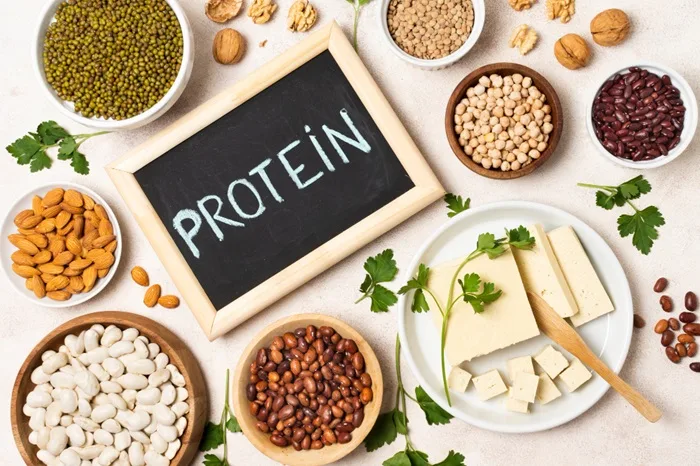When you’re managing diabetes, carbohydrates often take center stage. You learn to count them, choose them wisely, and understand their direct impact on your blood sugar. But what if a different macronutrient holds one of the most important keys to better glucose control and overall health? It’s time to turn the spotlight onto protein. Understanding the relationship between protein and diabetes is a game-changing strategy for anyone looking to achieve more stable blood sugar levels and feel their best.
This isn’t just about eating more meat. It’s about strategically using protein to build satisfying meals that nourish your body and work with your health goals, not against them. This ultimate guide will cover everything you need to know—from the science of how protein affects your blood sugar to the very best sources to put on your plate. Get ready to harness the power of protein.
How Does Protein Affect Blood Sugar? The Science Explained
While carbohydrates are broken down into glucose relatively quickly, protein follows a much different path in your body. This difference is what makes it such a valuable tool for diabetes management.
A Slower, Gentler Impact
The most important takeaway is that protein has a minimal direct impact on blood sugar levels. When you eat protein, it is digested much more slowly than carbohydrates. This slow-down effect is incredibly beneficial when you eat a mixed meal. Consuming protein alongside carbohydrates helps to buffer the absorption of sugar into the bloodstream, leading to a more gradual and gentle rise in glucose rather than a sharp, sudden spike.
Can Too Much Protein Raise Blood Sugar?
This is a common and important question. While protein itself doesn’t contain sugar, your body is resourceful. Through a process called gluconeogenesis, your liver can convert amino acids from excess protein into glucose if your body needs it. However, as confirmed by research from the American Diabetes Association, for most people with type 2 diabetes, a typical serving of protein will not significantly raise blood sugar. The effect is much more pronounced with very large quantities of protein in the absence of carbohydrates. The key is balance, not excess.
The Best Sources of Protein for a Diabetes-Friendly Diet
Not all protein sources are created equal. The goal is to choose high-quality proteins that are low in saturated fat and come with other nutritional benefits. Here are some of the best choices for a diabetes-friendly diet.
High-Quality Lean Meats and Poultry
Lean animal proteins provide all the essential amino acids your body needs without an overload of unhealthy fats.
- Examples: Skinless chicken breast, turkey breast, lean cuts of pork (like tenderloin), and lean beef (like sirloin or 90/10 ground beef).
Fatty Fish: The Heart-Healthy Protein
People with diabetes have a higher risk of heart disease, making fatty fish a true superfood.
- Examples: Salmon, mackerel, sardines, herring, and albacore tuna.
- Why they’re great: They provide both high-quality protein and powerful anti-inflammatory omega-3 fatty acids. An Easy & Heart-Healthy Mediterranean Grilled Salmon Recipe is a perfect way to incorporate this into your weekly routine.
Plant-Based Powerhouses: Legumes and Lentils
These are a fantastic win-win, offering a powerful combination of protein and blood-sugar-stabilizing fiber.
- Examples: Lentils, chickpeas, black beans, pinto beans, and kidney beans.
- Why they’re great: The fiber-protein duo makes them incredibly filling and gives them a very low glycemic index. Our list of 20 Best High-Fiber Foods for Diabetes Management highlights many of these stars.
Eggs and Dairy
These are convenient, affordable, and versatile protein sources.
- Examples: Eggs, plain Greek yogurt, cottage cheese, and low-fat milk.
- Why they’re great: An egg is a perfect portion of high-quality protein. Plain Greek yogurt and cottage cheese are packed with slow-digesting casein protein, making them excellent choices for a filling snack or breakfast.
Nuts, Seeds, and Soy Products
Don’t overlook these plant-based options for a dose of protein, healthy fats, and fiber.
- Examples: Almonds, walnuts, pistachios, chia seeds, tofu, and edamame.
- Why they’re great: They are some of the best Superfoods for Diabetes Control because they offer a complete nutritional package that supports both blood sugar management and heart health.
How Much Protein Do You Need?
There is no one-size-fits-all answer to this question. Your ideal protein intake depends on factors like your age, weight, activity level, and kidney function. A common guideline for people with diabetes is for protein to make up about 15-20% of total daily calories.
However, it is crucial to consult with your doctor or a registered dietitian. They can give you a personalized recommendation based on your specific health needs. Once you have your target, you can use the principles of Mastering Portion Control to ensure you’re hitting your goals without overdoing it.
Building the Perfect Diabetes-Friendly Meal with Protein
Knowing the best protein sources is one thing; knowing how to build a meal around them is another. Here’s how to do it effectively.
The Diabetes Plate Method Revisited
This simple visual method is the easiest way to build a balanced meal.
- Fill half your plate with non-starchy vegetables (like leafy greens, broccoli, or bell peppers).
- Fill one-quarter of your plate with a high-quality lean protein source (like a chicken breast or salmon fillet).
- Fill the final quarter with a smart, high-fiber carbohydrate (like quinoa, beans, or a small sweet potato).
Smart Snacking with Protein
A common mistake is reaching for a carb-only snack, which can cause a quick blood sugar spike. Including protein in your snacks can make a huge difference. Instead of just an apple, have an apple with a tablespoon of almond butter. Instead of just crackers, have them with a slice of cheese or a hard-boiled egg. Our guide to Smart Snacking for Diabetes has even more great ideas.
Timing Your Protein Intake
Spreading your protein intake evenly throughout the day is more effective than having one very large protein meal. Including a good source of protein at breakfast, lunch, and dinner helps manage hunger, preserve muscle mass, and promote stable blood sugar levels from morning to night. For more on this, explore the topic of Best Meal Timing for Diabetes.
Common Myths About Protein and Diabetes
Let’s debunk a few common misconceptions.
- Myth: Protein has zero effect on blood sugar.
- Fact: While the effect is minimal compared to carbs, your body can convert excess protein into glucose. Balance and portion size are key.
- Myth: You can eat as much protein as you want.
- Fact: Excess protein still contains calories and can contribute to weight gain if over-consumed. Furthermore, individuals with pre-existing diabetic kidney disease may need to limit their protein intake.
- Myth: All protein is the same.
- Fact: A lean chicken breast and a fatty, processed sausage have vastly different impacts on your overall health. Prioritizing lean and plant-based proteins is crucial.
Understanding the relationship between protein and diabetes is empowering. It shifts the focus from simple restriction to strategic eating. By choosing high-quality protein sources and balancing them with fiber-rich carbs and healthy fats, you can create delicious, satisfying meals that work for you, helping you stabilize your blood sugar and take confident control of your health.
Check out the author’s book here: Diabetic Air Fryer Cookbook.


Leave a Reply